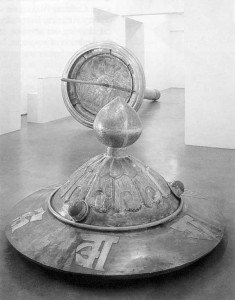For ‘Flash Art’ magazine

Since ancient times, Buddhist civilizations have erected monumental sculptures like the cliffside Buddhas destroyed last year in Afghanistan. Carrying on the tradition in a distinctly avant-garde vein, Huang Yong Ping devised an ultimately unrealized project to install a 15 meter high Buddhist prayer wheel in the Christian Chapelle St Louis Salpétrière in Paris and surround it with Islamic tapestries. The enormous, dismantled wheel, and a scale model of the church are the basis for ‘Om Mani Padme Hum’, Huang’s latest New York show.
In Tibet, devotees spin handheld wheels in prayer. With Huang’s version, only a god-sized hand could wield the massive rod, made from an entire tree trunk. The rod and the lid occupy one room, while the circular drum housing a giant scroll covered in written prayers rests on its side in the back gallery. Two spiraling scrolls, one a Tibetan sutra and the other a text from the Koran, descend from the ceiling and a scale model of Salpétrière with motorized wheel rests on a Persian carpet. A modern version of an ancient chariot and a long scroll complete the exhibition.
Huang’s use of monumental scale is not unprecedented in his work. Nor has he shied away from overtly Buddhist imagery, once combining a bottle rack structure on the order of Duchamp, with 50 pairs of arms to create a version of the multi-armed deity Guan-Yin. Since his involvement in the radical Xiamen Dada group in the late 80s, Huang has strategically incorporated Western ideas into his Buddhist influenced philosophy. But given the artist’s past attack on the West’s self-perceived hegemony, it doesn’t seem likely that he is hoping for the reconciliation of three different faith systems by simply placing their symbols in proximity to each other. In previous work, Huang has often used insects and reptiles, often enclosing them together, forcing them to kill or be killed. Considering that the creatures were intended to represent different cultures, the Salpétrière project may be the subversive opposite of a wish to homogenize the world’s religions.